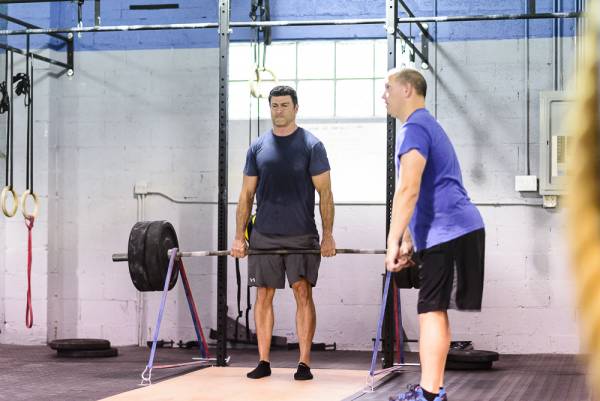At Breaking Muscle, we have some great authors discussing many programming ideas and fundamentals of training. For the beginner to the seasoned athlete, all of these choices would seem to be a good thing. However, research indicates that having too much choice may not be so good.
Let’s start with the scope of choice that we have in available programming for just a few fitness goals (sorry for all the great programs I leave out; it is certainly not meant to be a comprehensive list):
CrossFit
- Your local affiliate’s programming
- CrossFit Main Page
- Outlaw Way
- OPT
- Competitors WOD
- CrossFit Invictus
- Competitors Training
StrongFirst or RKC Kettlebell Certification
Strength Training
Olympic Weight Lifting
Wait a Minute, Choice is Not Always Good?
I am not sure how you feel after reading this list, but I know I got excited creating it. I love reading about programming philosophy and thinking about how I can utilize it in my coaching and for my personal goals. I have often jumped from program to program because of this excitement.
And this is exactly why having too much choice can sabotage us. Let’s take a look at what economists and social scientists say are the four most common problems with too much choice:
1. Paralysis
Have you ever been in the grocery store and felt completely overwhelmed? I get that way with picking out toothpaste. There are types of toothpaste that reduce plaque, have 24-hour protection, or are “advanced.” I can’t even tell which one is supposed to be the best. So many features to choose from with this very simple product.
When we have too many choices, we tend to get stopped in our tracks and not make any choice. I work out at fully stocked strength and conditioning facility and if I don’t have a plan beforehand, I wander around from movement to movement because I just can’t choose. Maybe having only a few kettlebells is nice because then choices are a bit more limited.
Sheena Iyengar and Mark Lepper found that choice demotivates people to take action.2 They asked people to taste jam in an upscale grocery store. When participants had only six choices, they were much more likely to buy one than if they had 24 choices. Similarly, Iyengar and colleagues found a similar trend when asking people to choose a retirement account.1 When given the choice of many funds, most people did not choose a retirement fund (even though they gave up a great deal of matching employer funds by not choosing).
Thus, if a person is trying to determine the best possible program for themselves, he or she may not choose to do anything because of the overwhelming number of choices.

Photos courtesy of CrossFit Empirical
2. Thinking About Opportunity Costs
Opportunity cost is an economic term that defines what we give up when we choose to engage in an activity. For example, if you chose to focus your workout practice on Olympic weightlifting, then you would lose out on the opportunity to get better at deadlifts.
The problem for us comes in when we think about what we are missing. I have always wanted to get better at weighted pistols and every few workouts I think about it. This attention to opportunity costs makes me less happy with my workout and gets me thinking about what I am missing. We may even do that with programming. A person could be doing the Easy Strength program and wonder what would happen if he or she switched to the Wendler 5/3/1 program.
When we start worrying about what we are missing, it affects our performance and happiness with our current program.
3. Escalation of Expectations
With all of the choices in the list above, it would seem like I could train to be an outstanding athlete or coach someone to an elite level. Some programs have fancy calculators (e.g., Smolov squat routines or 5/3/1) or have been tested by top-ranked athletes. With all of these great “features” in these programs, I expect to have a great outcome.
But if all I had was an old Muscle and Fitness magazine with only one workout in it, I wouldn’t expect as much. I have heard gym owners sometimes wish that they could just open up a grungy old garage gym. There they could go back to the simpler days of training without all of the extra equipment.
I am guessing the reason they want to go back to the good ol’ simpler days is that it would lower people’s expectations.
4. It is your Fault if the Choice doesn’t Work
With all of the choice and the escalation of the expectations, there is only one person responsible if you don’t [insert your goal here]. If you are following your coach’s program, you can complain about it all you want and not take home any of the responsibility.
However, if you are picking a program with all of the choices available to you, you have now given yourself the responsibility. “If only I had found a better program or read more information.

Photos courtesy of CrossFit Empirical
How do We Fix the Problems Associated with Choice?
- Limit Your Choice – If your main focus is CrossFit there are always many skills on which to focus. From a behavioral economist’s perspective, it is a program built on way too much choice (and a poor reinforcement schedule). One suggestion is to follow your coach’s program strictly (then it is your coach’s fault if it doesn’t get you prepared). If you are more advanced, plan out your goals a year in advance. If you goal is the CrossFit Open next year, you can plan out cycles until that event (e.g., powerlifting strength cycle followed by an Olympic weightlifting skill and strength program followed by more CrossFit-like programming a month out from the event start). With any plan, make sure you give it enough time. Don’t jump to a new plan from week to week.
- Train for Something – I found that training for kettlebell, barbell, and bodyweight certifications caused me to focus in preparation for each. I set up three- to six-month training cycles for each. Train and do a powerlifting event or Olympic weightlifting event. Having a goal can really help you focus your energy.
- Pick a Program That Is Right for You – Everyone is different and not all programs will be a good fit. I see some of the advanced Westside Barbell athletes and I would love to follow their program. However, my body (i.e., my recovery methods) are not able to keep up with the rigor of the program.
The Take-Home
In general, having more choices seems like a good idea. However, it has some negative consequences that may interfere with your training. Focusing on one program and limiting choice is helpful to keep you motivated for your goals.
For more check out Bob Takano’s discussion of how there are no secret programs.
References:
1. Iyengar, SS., et al. “How Much Choice Is Too Much? Contributions to 401 (k) Retirement Plans.” Pension Design and Structure: New Lessons from Behavioral Finance, 83–95. 2004.
2. Iyengar, SS., et al. “When Choice Is Demotivating: Can One Desire Too Much of a Good Thing?” Journal of Personality and Social Psychology 79 (6): 995. 2000.






